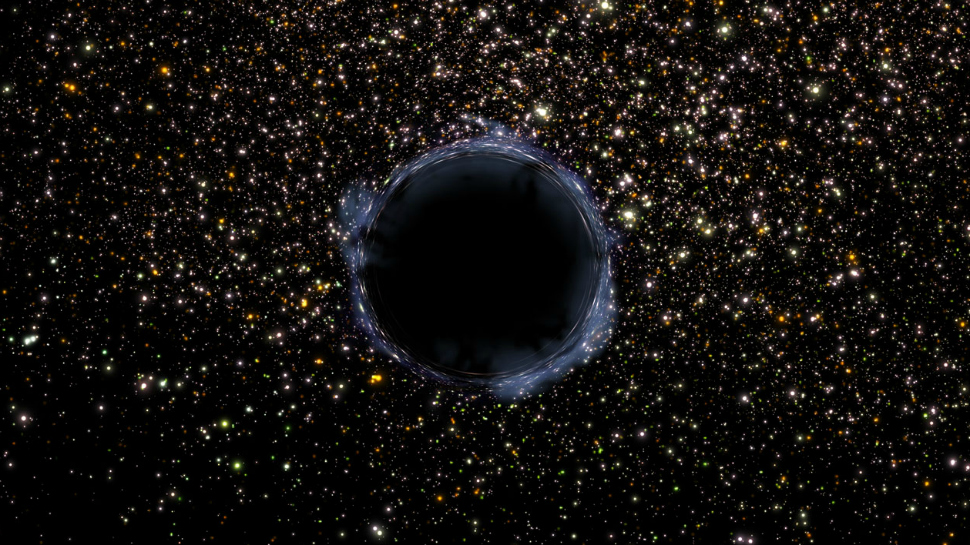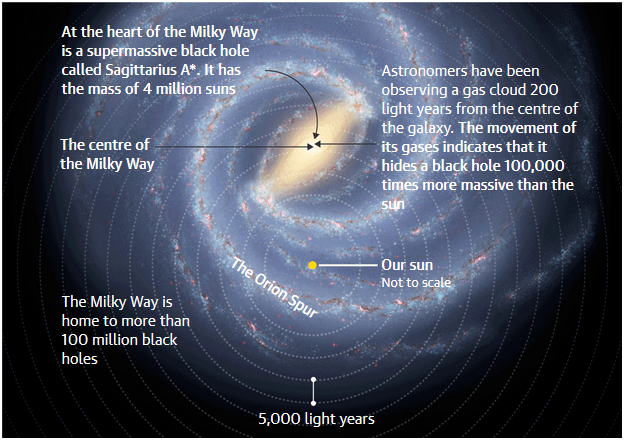Near the center of the Milky Way found a supermassive black hole

Japanese astronomers have discovered evidence of the existence of a giant black hole in the Milky Way. As far as can be judged, it ranks second in size after its own “relative” from the center of our galaxy, a giant black hole, which was named Sagittarius A * . The supermassive object was discovered using a telescope from the Paranal Observatory , located in the Atacama Desert (Chile). There is a newly discovered black hole in a large gas nebula near the center of our galaxy, 200 light years away.
Initially, astronomers did not suspect the existence of such a massive object. They just wanted to understand why the nebula, which they had been observing for a long time, behaves somewhat strangely. Unlike other interstellar nebulae, gases (hydrogen cyanide and carbon monoxide) here moved at different speeds in different parts of it, and these fluctuations could not be explained by some kind of internal dynamics, devoid of external influence. The diameter of the nebula is more than 150 trillion kilometers.
After a detailed study of it , it turned out that the gas molecules here are under the influence of powerful gravitational forces. When modeling the characteristics of objects that can have such an impact, it turned out that there is only one option - the presence of a supermassive object with a diameter of 1.4 trillion kilometers. This black hole is located right in the center of the nebula, and the gas molecules move under the influence of radio waves generated by a black hole, whose mass reaches 100 thousand solar masses.
Japanese scientists claim that the discovery of such a large black hole is an unprecedented discovery. And this is indeed the case - an object of this size, for the first time astronomers come across almost randomly (the center of the Milky Way does not count, because a supermassive black hole in the center of the galaxy has been known for a relatively long time). The mass of Sagittarius A * is about 4 million solar masses.

Now experts are aware of several types of black holes, including those of medium-weight black holes . Objects that belong to this type have a mass of more small black holes of stellar mass (another type, the mass of such objects is from 10 to several tens of masses of the Sun), but smaller than that of a supermassive black hole (from a million to hundreds of millions of masses of the Sun ).
Relatively small black holes are formed during the gravitational collapse of stars. As far as can be judged, there are about 100 million objects of this type in the Milky Way. Black holes of average mass were formed about the same. But about the process of formation and evolution of supermassive black holes, to which Sagittarius A * belongs, nothing was known.
“We know that small black holes appear after the death of stars, which makes them fairly ordinary. We think that some of them after some time form larger black holes, which, in turn, are the beginning of the formation of supermassive objects, with a mass that is millions of times greater than the mass of an ordinary black hole, ”said Brooke Simmons of the University of California at San Diego (US).
One hypothesis says that massive and supermassive objects form when small black holes merge, but this process takes place almost exclusively in the center of the galaxy. If so, then the discovered supermassive black hole was once the center of the galaxy . Only not the Milky Way, but some other, dwarf galaxy. And just as she was absorbed by the Milky Way billions of years ago. The galaxy eaten ’by a stronger neighbor was distributed throughout the entire volume of our galaxy, but its center remained untouched.
What happens next with the black hole detected? According to Japanese scientists, it gradually shifts to the center of the Milky Way, and eventually merges with Sagittarius A *, which will make the black hole in the center of the galaxy much more massive than it is now. Experts continue to observe the gas nebula, in which a black hole is located, in order to clarify previously obtained data, which will clarify the origin of the object. In the near future, the Japanese will be engaged in precisely this task.
All Articles